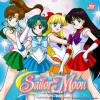
Do Your Bit for Fabulosity.
Don’t hesitate, just donate.
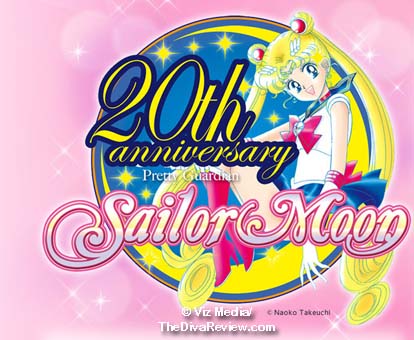 In
Japan, it’s not exactly front page news for a popular manga to be made
into an animated televison series. It might be the dream of every
author - or mangaka - to have their work dance across TV screens in
their home country, and perhaps if they’re very lucky, even shown in
some relative form in other parts of the world. What is it then that
makes one such cartoon a cultural sensation?
In
Japan, it’s not exactly front page news for a popular manga to be made
into an animated televison series. It might be the dream of every
author - or mangaka - to have their work dance across TV screens in
their home country, and perhaps if they’re very lucky, even shown in
some relative form in other parts of the world. What is it then that
makes one such cartoon a cultural sensation?
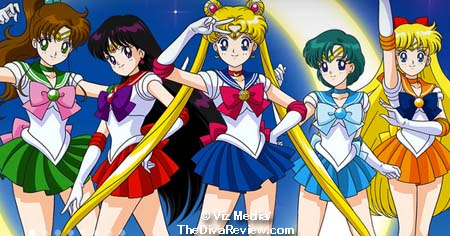 In
the case of the seminal 1992 anime series, Sailor Moon, based on the
manga by Naoko Takeuchi, it might’ve been the culmination of several
factors. Timing: For many fans both in Japan and around the world,
where it was adapted into many different languages, Sailor Moon was the
primary example of the “magical girl” genre; an average young girl
suddenly discovers powers she never knew she had and then must figure
out how to use them to save the world. For many little girls watching,
it was the first anime marketed for and to them, as opposed to the
endless sea of boys’ genres. It might have also been the first example
of heroines that could be both feminine and kickass. Takeuchi’s group
of five schoolgirl warriors were silly, clumsy, cranky, shy, boy-crazy,
lonely, loyal, misunderstood, courageous, and all the different
qualities that can lie within a young girl’s heart. They even turned
the fetishised fuku – the Japanese schoolgirls’ naval-inspired uniform -
into a symbol of power, and beat up the bad guys and stood up for
themselves and each other while working fabulous shoes. Tiaras,
brooches and compacts became weapons of war. Transformation sequences
were lengthy and important; focusing on their costume change from heels
to sparkly fingernail tips.
In
the case of the seminal 1992 anime series, Sailor Moon, based on the
manga by Naoko Takeuchi, it might’ve been the culmination of several
factors. Timing: For many fans both in Japan and around the world,
where it was adapted into many different languages, Sailor Moon was the
primary example of the “magical girl” genre; an average young girl
suddenly discovers powers she never knew she had and then must figure
out how to use them to save the world. For many little girls watching,
it was the first anime marketed for and to them, as opposed to the
endless sea of boys’ genres. It might have also been the first example
of heroines that could be both feminine and kickass. Takeuchi’s group
of five schoolgirl warriors were silly, clumsy, cranky, shy, boy-crazy,
lonely, loyal, misunderstood, courageous, and all the different
qualities that can lie within a young girl’s heart. They even turned
the fetishised fuku – the Japanese schoolgirls’ naval-inspired uniform -
into a symbol of power, and beat up the bad guys and stood up for
themselves and each other while working fabulous shoes. Tiaras,
brooches and compacts became weapons of war. Transformation sequences
were lengthy and important; focusing on their costume change from heels
to sparkly fingernail tips.
Sadly, due to the overseas licenses being cast over a variety of different distributors, Sailor Moon was neither produced with any regularity, nor in full on home video. Neither has it been on US television regularly since the earliest days of Cartoon Network. Sailors Moon, Mars, Jupiter, Mercury and Venus seemed to have become icons whose significance was buried under the decades. Finally, thanks to Viz Media acquiring the rights to all five Sailor Moon television anime sagas, as well as their feature films and OVAs, the drought is over. While there seems to be a renaissance around the word “feminism,” it’s the perfect time for the world to be reminded of the magical celestial quintet that defined by example.
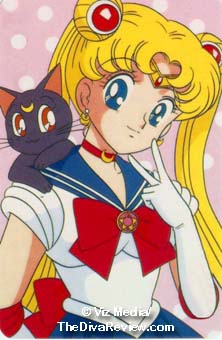 Usagi
Tsukino is an average middle school student living in Japan with her
average family, getting (slightly sub-) average grades. Her
marks and getting to school on time are her only worries, until Usagi
rescues a mysterious black cat with a golden crescent emblazoned on its
forehead that decides to converse with her. After meeting Luna, the
talking kitty, Usagi’s pretty much primed for anything bizarre; so when
the cat exposes her to an unseen world full of monsters and
intergalactic evil taking place all around, Usagi is handed a brooch and
told to speak a chant that turns her into a sailor-suited superhero.
Though terrified, the clumsy, scaredy-cat Usagi swings with this
development relatively nicely. Same goes for the next four
unsuspecting, ordinary girls chosen by Luna as likely reincarnations of
the Sailor Senshi {Soldiers}, a royal court of warrior princesses
from another time, sent to earth to find and protect the Legendary
Silver Crystal and thereby save the universe from the tyranny of the
Dark Kingdom.
Usagi
Tsukino is an average middle school student living in Japan with her
average family, getting (slightly sub-) average grades. Her
marks and getting to school on time are her only worries, until Usagi
rescues a mysterious black cat with a golden crescent emblazoned on its
forehead that decides to converse with her. After meeting Luna, the
talking kitty, Usagi’s pretty much primed for anything bizarre; so when
the cat exposes her to an unseen world full of monsters and
intergalactic evil taking place all around, Usagi is handed a brooch and
told to speak a chant that turns her into a sailor-suited superhero.
Though terrified, the clumsy, scaredy-cat Usagi swings with this
development relatively nicely. Same goes for the next four
unsuspecting, ordinary girls chosen by Luna as likely reincarnations of
the Sailor Senshi {Soldiers}, a royal court of warrior princesses
from another time, sent to earth to find and protect the Legendary
Silver Crystal and thereby save the universe from the tyranny of the
Dark Kingdom.
The Blu-ray episodes in Viz’s Season 1 are gorgeous. Encompassing episodes 1 to 23, the cleanup on the 22-year-old hand-drawn series is just beautiful. The candy colours that permeate the series, particularly around the girls’ daytime activities are bubbly and vivid. The initial attacks by the Dark Kingdom’s Youma, or monsters, take place in the rich, shadowy blues of night time. It is called Sailor Moon, after all, ne?
Of course, as even the Senshi of the future could not have predicted HDTV or Blu-rays, the show was not shot in today’s 16:9 aspect ratio. As a result, there are boxes on the sides of the TV screen to keep the complete original square picture without stretching (like vertical letterbox).
Oddly, the DVD included in the Limited Edition Blu-ray/DVD combo set does not have nearly as sharp an image as the Blu-ray version. The backgrounds are often staticky and the pumped-up colour only adds noise and can be a bit hard on the eyes. There are also blurs around outlines and noise around the subtitles themselves in certain frames. This is a very noticeable distraction. Also, the DVD bears Dolby 2-channel stereo sound, compared to the Blu-ray’s full, crystal-clear DTS-HD audio. Go with the Blu-ray if possible. I hope Viz (or Sailor Moon’s parent company, Toei) fixes these very noticeable problems, particularly with the DVD picture in upcoming sets.
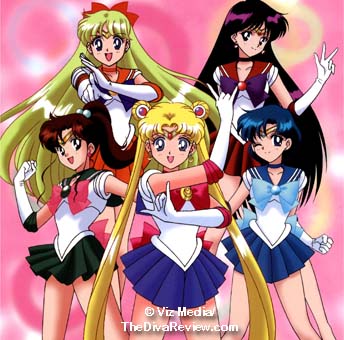 I
freely admit to jumping up and down like a fool at the first clock
chimes that ring in Sailor Moon’s theme song, Moonlight Romance. The
audio track has been cleaned up, as well, and I’m hearing all sorts of
loopy background music I’m kind of glad I missed the first time around.
There’s the English translation of the theme song lyrics at the top of
the screen, though some of the Japanese expressions are untranslated for
no reason I can see. As part of the extras, you can view the themes
with full Romanji sing along subs, or clean with no text at all.
I
freely admit to jumping up and down like a fool at the first clock
chimes that ring in Sailor Moon’s theme song, Moonlight Romance. The
audio track has been cleaned up, as well, and I’m hearing all sorts of
loopy background music I’m kind of glad I missed the first time around.
There’s the English translation of the theme song lyrics at the top of
the screen, though some of the Japanese expressions are untranslated for
no reason I can see. As part of the extras, you can view the themes
with full Romanji sing along subs, or clean with no text at all.
The episodes are shown in full, which means we not only get a post-opening credits episode preview, but Usagi reminds at the start of each chapter who exactly Sailor Moon is and where her evolving powers are at that moment. I also noticed small scenes I couldn’t recall from the original US dub that were possibly cut for time, so it was great to see them as was intended – more or less.
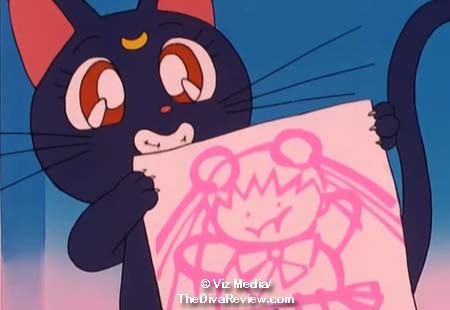 Some
content changes that struck me from my memories of the original DiC dub,
compared to this new Viz version, include the appearance of terminology
that wasn’t readily used at the time. She very much is one, but the
word “fangirl” was not common verbiage in 1992, so hearing Rei use it to
chastise a squealing, hyperactive Usagi feels odd. There’s also a clear
attempt to make things more politically correct that makes me a little
dubious about the “uncut”-ness of the set: The teasing that was common
until recent years, having since become “fatshaming,” has changed
Usagi’s quest to become “skinny” after gaining a whopping half pound to
a more wholesome desire to “get fit.”
Some
content changes that struck me from my memories of the original DiC dub,
compared to this new Viz version, include the appearance of terminology
that wasn’t readily used at the time. She very much is one, but the
word “fangirl” was not common verbiage in 1992, so hearing Rei use it to
chastise a squealing, hyperactive Usagi feels odd. There’s also a clear
attempt to make things more politically correct that makes me a little
dubious about the “uncut”-ness of the set: The teasing that was common
until recent years, having since become “fatshaming,” has changed
Usagi’s quest to become “skinny” after gaining a whopping half pound to
a more wholesome desire to “get fit.”
Also, as any old school Sailor Moon fan knows, Usagi’s a “crybaby,” plain and simple. A squalling, wailing ball of overreaction that has now softened into her being “emotional,” ostensibly to sound less like name-calling, “crybaby” is never used.
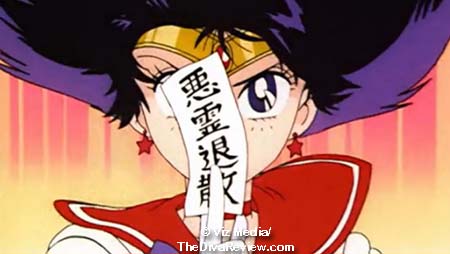 Sailor
Mars’ earthly form, the proud Shinto shrine maiden, Rei Hino, is now a
labeled a “psychic,” with little reference to her abilities as a miko,
which I guess eliminates any controversy that her powers stem from any
religious basis (Never mind the angry guardian deity that appears in
her exorcisms and the flaming ofuda she throws so well.) However,
the flip side of that is keeping Rei’s shrine keeper grandfather the
dirty old man he was in the original source.
Sailor
Mars’ earthly form, the proud Shinto shrine maiden, Rei Hino, is now a
labeled a “psychic,” with little reference to her abilities as a miko,
which I guess eliminates any controversy that her powers stem from any
religious basis (Never mind the angry guardian deity that appears in
her exorcisms and the flaming ofuda she throws so well.) However,
the flip side of that is keeping Rei’s shrine keeper grandfather the
dirty old man he was in the original source.
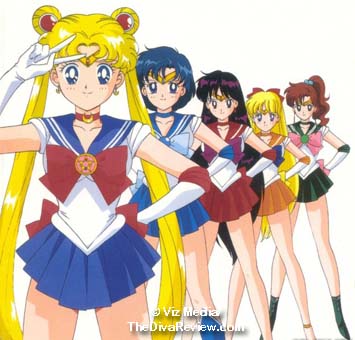 The
new dub: One of my issues with Viz’s voice actors is their indistinction.
The Japanese seiyuu (voice actors) become instantly recognisable
as their given role, with each voice different and adding insight to the
character’s personality. Sailor Moon in Japanese is a great example of
that, where fans can easily identify which character is speaking simply
by the sound of their voice. There is rarely such a fit between
character and actor in Viz’s ADR. Often it sounds like the roles are
given to anyone with good reading skills and a pleasant voice, which is
not enough. As Usagi’s superhero guide, Luna, the talking cat, Michelle
Ruff is completely unmemorable with no inflections at all to give life
or personality to the character. The same with Kate Higgins as Sailor
Mercury, and her alter-ego, the shy, super-genius bookworm, Ami Mizuno.
Though Christina Vee as Usagi’s strict taskmaster, Sailor Mars, gives
some toughness to the character, I do so wish the actors would stop
over-enunciating end consonants like they’re reading and sound more
natural in their delivery.
The
new dub: One of my issues with Viz’s voice actors is their indistinction.
The Japanese seiyuu (voice actors) become instantly recognisable
as their given role, with each voice different and adding insight to the
character’s personality. Sailor Moon in Japanese is a great example of
that, where fans can easily identify which character is speaking simply
by the sound of their voice. There is rarely such a fit between
character and actor in Viz’s ADR. Often it sounds like the roles are
given to anyone with good reading skills and a pleasant voice, which is
not enough. As Usagi’s superhero guide, Luna, the talking cat, Michelle
Ruff is completely unmemorable with no inflections at all to give life
or personality to the character. The same with Kate Higgins as Sailor
Mercury, and her alter-ego, the shy, super-genius bookworm, Ami Mizuno.
Though Christina Vee as Usagi’s strict taskmaster, Sailor Mars, gives
some toughness to the character, I do so wish the actors would stop
over-enunciating end consonants like they’re reading and sound more
natural in their delivery.
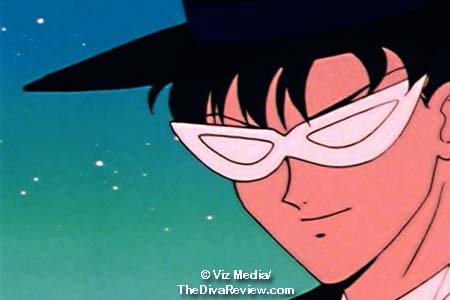 On
the flip side of that complaint is Stephanie Sheh, warming up quickly as
the episodes roll on as Usagi. One can hear Sheh really starting to
feel and embody the character, capturing the goofiness and silliness of
our often ditzy heroine. Sheh still needs to work on making Sailor
Moon’s trademark presto-change-o tip-off, “Moon Prism Power, Make Up!”
sound much more epic. Then again it’s a lot to ask anyone to fill the
shoes of the amazing original (and current!) Japanese Sailor Moon
seiyuu, Kotono Mitsuishi. Robbie Daymond is on par - if not actually
better - than his Japanese counterpart as Mamoru/Tuxedo Mask, though
it’s a bit hard to say because it’s not like the original Mamoru was
brimming over with sparkling personality. The bad guys - evil Queen
Beryl, her Four Kings of Heaven (In this set, we meet three of them,
Jadeite, Zoisite and Nephrite) and the various monsters of the day -
bring some scene-chomping oomph to their deliveries. The other note I’d
make about the ADR is, I don’t know if it’s the dubbing or the script,
but sometimes the dialogue, awkward and cheesy, yet cute as it may be,
actually sounds awkward and cheesy in this dub without being cute, and
that’s not so good.
On
the flip side of that complaint is Stephanie Sheh, warming up quickly as
the episodes roll on as Usagi. One can hear Sheh really starting to
feel and embody the character, capturing the goofiness and silliness of
our often ditzy heroine. Sheh still needs to work on making Sailor
Moon’s trademark presto-change-o tip-off, “Moon Prism Power, Make Up!”
sound much more epic. Then again it’s a lot to ask anyone to fill the
shoes of the amazing original (and current!) Japanese Sailor Moon
seiyuu, Kotono Mitsuishi. Robbie Daymond is on par - if not actually
better - than his Japanese counterpart as Mamoru/Tuxedo Mask, though
it’s a bit hard to say because it’s not like the original Mamoru was
brimming over with sparkling personality. The bad guys - evil Queen
Beryl, her Four Kings of Heaven (In this set, we meet three of them,
Jadeite, Zoisite and Nephrite) and the various monsters of the day -
bring some scene-chomping oomph to their deliveries. The other note I’d
make about the ADR is, I don’t know if it’s the dubbing or the script,
but sometimes the dialogue, awkward and cheesy, yet cute as it may be,
actually sounds awkward and cheesy in this dub without being cute, and
that’s not so good.
Part of the joy of the package is that the original Japanese voice track is included (In the same lovely quality as the English audio. How frustrating when anime dub distributors put the Japanese audio on a lesser quality track.) with English subtitles. So if you are a purist, and wish to hear no English soiling your Sailor Moon experience, or are curious to hear the iconic original seiyuu, Viz has got you covered.
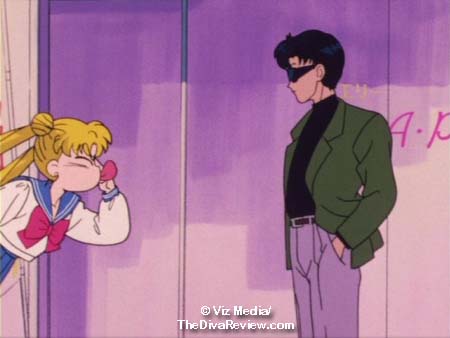 No
Bunnys here, folks. Viz’s dub also uses the correct Japanese names of
the Sailor Senshi. The girl most westerners know as Serena or Bunny is
right and properly Usagi Tsukino. Sailor Mercury is now Ami (Ah-mee)
as opposed to Amy (Ay-mee). Darien has become Mamoru (But
oddly, his alter ego is Tuxedo Mask, not Kamen. Ah, consistency…),
friend Molly is Naru, and somewhat sadly, eternal nerd Melvin has been
correctly called Umino. Unfortunately, my long-standing peeve of their
changing the pronunciation of the Japanese names still pops up (The
name mutilation in their Bleach and Inu Yasha dubs should be a
punishable offence) but it’s nearly not as bad as in previous
projects.
No
Bunnys here, folks. Viz’s dub also uses the correct Japanese names of
the Sailor Senshi. The girl most westerners know as Serena or Bunny is
right and properly Usagi Tsukino. Sailor Mercury is now Ami (Ah-mee)
as opposed to Amy (Ay-mee). Darien has become Mamoru (But
oddly, his alter ego is Tuxedo Mask, not Kamen. Ah, consistency…),
friend Molly is Naru, and somewhat sadly, eternal nerd Melvin has been
correctly called Umino. Unfortunately, my long-standing peeve of their
changing the pronunciation of the Japanese names still pops up (The
name mutilation in their Bleach and Inu Yasha dubs should be a
punishable offence) but it’s nearly not as bad as in previous
projects.
 As
part of the lovely Limited Edition Season One box set, there is an
88-page booklet bearing an episode guide for the entire first series,
character profiles for all the Senshi and their friends, song lyrics in
English, Japanese and Romanji and a fab gallery of official artwork.
The extras on the Blu-ray include the truly rousing first public
announcement of Viz’s Sailor Moon acquisition before an unwitting group
of anime fans. The reaction by the crowd, which clearly consists of
many not born when Sailor Moon debuted, is downright heartwarming.
Besides the feature films and OVAs, Viz’s property includes the original
series, as well as continuing sagas, Sailor Moon R, Sailor Moon S, and
Sailor Moon SuperS. There is also, most dearly to me, Sailor Moon
Stars, the fifth and final chapter of the television series, which was
never previously acquired by a western company, possibly because of the
gender-switching of a new group of Senshi, the Sailor Starlights, and
their romantic entanglements with the OT5. There’s no news on any
changes there, but from the announcement and trailer, it looks like that
other problematic sexual conundrum; the openly lesbian love story
between Sailor Neptune and Sailor Uranus from the third saga, Sailor
Moon S, is faced head on without creepily turning them into literal
kissing cousins, as occurred in the US dub.
As
part of the lovely Limited Edition Season One box set, there is an
88-page booklet bearing an episode guide for the entire first series,
character profiles for all the Senshi and their friends, song lyrics in
English, Japanese and Romanji and a fab gallery of official artwork.
The extras on the Blu-ray include the truly rousing first public
announcement of Viz’s Sailor Moon acquisition before an unwitting group
of anime fans. The reaction by the crowd, which clearly consists of
many not born when Sailor Moon debuted, is downright heartwarming.
Besides the feature films and OVAs, Viz’s property includes the original
series, as well as continuing sagas, Sailor Moon R, Sailor Moon S, and
Sailor Moon SuperS. There is also, most dearly to me, Sailor Moon
Stars, the fifth and final chapter of the television series, which was
never previously acquired by a western company, possibly because of the
gender-switching of a new group of Senshi, the Sailor Starlights, and
their romantic entanglements with the OT5. There’s no news on any
changes there, but from the announcement and trailer, it looks like that
other problematic sexual conundrum; the openly lesbian love story
between Sailor Neptune and Sailor Uranus from the third saga, Sailor
Moon S, is faced head on without creepily turning them into literal
kissing cousins, as occurred in the US dub.
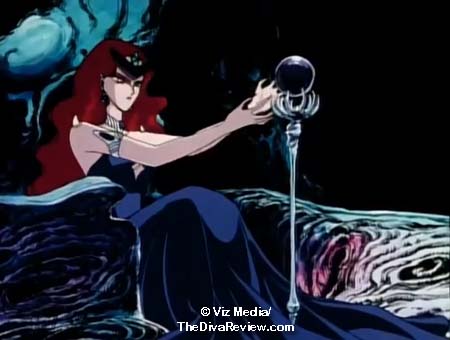 Hopefully,
Viz understands that besides the new, young fans who will adore Sailor
Moon as all of us who saw the series on television did, the people who
will line up for these uncensored views of our longtime faves are grown
now and have seen plenty of much stranger stuff in anime in the years
since Sailor Moon’s media absence to accept the cheerful weirdness and
ambiguities without freaking out. I have very high hopes.
Hopefully,
Viz understands that besides the new, young fans who will adore Sailor
Moon as all of us who saw the series on television did, the people who
will line up for these uncensored views of our longtime faves are grown
now and have seen plenty of much stranger stuff in anime in the years
since Sailor Moon’s media absence to accept the cheerful weirdness and
ambiguities without freaking out. I have very high hopes.
The collection as yet only goes up to episode 23, halfway through the first series, so we have not met the final Senshi, Sailors Jupiter and Venus, so I can’t speak about them as yet, but if Viz keeps the quality as high for their second part of series one as they’ve done with this first part, I’ll be back to give updates on those and the other chapters in the Sailor Moon saga.
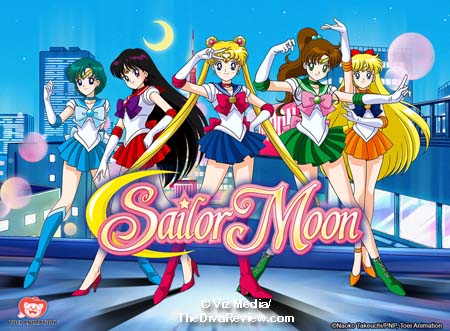 This
is a must-have for any anime fan. A real piece of pop culture history,
treated with according care by Viz. Kids, make sure you write the
Sailor Moon Limited Edition Box Set in big letters on your Christmas
list for Santa.
This
is a must-have for any anime fan. A real piece of pop culture history,
treated with according care by Viz. Kids, make sure you write the
Sailor Moon Limited Edition Box Set in big letters on your Christmas
list for Santa.
~ The Lady Miz Diva
November 11th, 2014
© 2006-2022 The Diva Review.com
|
|




